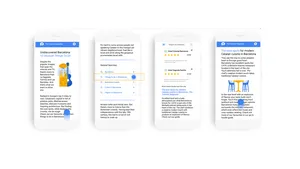AdSense best practice: Set yourself up for success
7 minutes to read
In part two of our series for new publishers to turn their #PassionIntoProfit, we’ll cover three steps you can take to set up you up for success. Following these insights won’t guarantee success, however it will give more opportunities for your ads to perform, while making sure they complement your site’s user experience.
To get started, we’ll discuss three topics:
- Optimal ad placement
- Mobile optimization
- How to avoid policy violations
If you’re looking for an introductory overview of AdSense, check out the first part of this series where we cover the basics of AdSense.

Make the most of your ad placement
It’s important to keep the user in mind when deciding where to place ads. You want your ads to perform well, but adding too many can clutter your page for users.
Before you decide where to place ads, ask these 4 questions:
- How do your users engage with your site?
- Where is their attention going to be focused?
- How can you place ads in focus areas without getting in the way of your content?
- How can you keep all of your pages easy to navigate?
It’s a best practice to place ads next to the content your visitors are most likely to focus on, but take the time to make sure ads are clearly separate and identifiable from your content. Remember that ads that confuse or mislead visitors violate the AdSense program policies and are not allowed. Other ad placement actions that can lead to policy violations include:
- Mirroring or rewriting content from other sources without adding value
- Pages with more advertising than publisher content
- Using automatically generated content
- Hosted ad pages or pages with no content
- Sites that don’t follow our Webmaster Guidelines
Here are a few ad placement best practices that may improve the viewability of your ads.
- For mobile sites, place a 320x100 ad above the fold, where it will be visible to everyone who lands on your page.
- For desktop sites, use vertical ad units, which remain visible as users move around a page. The 300x600 layout is one of the fastest growing ad sizes, and is popular with advertisers who want to increase brand awareness.
- Try to lay out your content in a way that holds your visitor’s attention and entices them to continue reading.
Optimize for mobile
Today, there are now more searches on mobile than on desktop. This increase in mobile traffic has increased user expectations of mobile site performance. Meeting the expectations of mobile users continues to be a challenge for publishers. 53% of mobile users will abandon a page that takes longer than 3 seconds to load, with that number rising to 74% for pages that take longer than 5 seconds.

Despite this heavy shift towards mobile, a recent study by Think With Google found that the average time it takes to load a mobile landing page is 22 seconds. Publishers who don’t adapt to mobile user needs are less likely to retain new visitors. This reduces their ability to convert site visits into ad revenue.
To get your mobile site up to speed, keep these insights in mind:
- Dedicate time to discover current issues on your mobile site: Tools like PageSpeed Insights, Mobile-Friendly Test, and Web Page Test will highlight the areas of your site that need attention.
- Optimize your mobile site for speed: Get rid of bulky content, reduce the number of server requests, and consolidate data and analytics tags. Prioritize loading elements that are visible above the fold first - styling, javascript logic, and images accessed after the tap, scroll, or swipe can be loaded later.
- Monitor your progress: Run regular A/B tests to audit performance and remove anything that lowers speed or harms user experience. Whenever you update your analytics data, evaluate your requests and remove outdated collection pixels.
Once you’ve got your fast mobile site running smoothly on small-screens, take these additional steps to maximize your profits and ensure that you’re compliant with the AdSense program policies.
- Help prevent accidental clicks by moving ad units 150 pixels away from your content.
- Use responsive ad units, which automatically adapt your ad sizes to fit any screen.
- Use the 320x100 ad size instead of the 320x50 where possible. By using the 320x100 ad unit, you allow the 320x50 ad to compete as well, doubling the fill-rate competition.
- Place a 320x100 ad unit just above the fold.
- Be as consistent as possible across screens - make it easy for users to find what they’re looking for regardless of the device they’re using.

Keep AdSense safe for everyone
After signing up for an AdSense account, you’ll need to make sure your website is policy-compliant before getting approved. While AdSense will work behind the scenes to maximize your performance, it’s your responsibility to make sure your content and placements adhere to AdSense policies. Violation of AdSense policies can lead to your account being suspended or your website removed from the network. To keep your account in good standing, follow these best practices:
- Don’t click your own ads, or ask others to click them. These clicks won’t count toward revenue and may lead to an account suspension. Even if you’re interested in an ad or looking for its destination URL, clicking on your own ads is considered an invalid click and is prohibited.
- Maximize content, not ads per page. It’s important that original, regularly updated content remains the focal point of your website.
- Don’t use deceptive layouts. If the line between your content and your ads becomes blurred to your readers, those ads will be flagged as a violation.
- Take responsibility for your traffic. Use Google Analytics to quickly identify and resolve unusual traffic patterns. If you’re unsure of what counts as invalid traffic, then watch this short video.
- Always follow the Code Implementation Guide and don’t try to modify your AdSense code.
Our Webmaster Guidelines provides detailed notes on how to avoid spammy content and our all-in-one compliance guide is a resource for you to reduce the possibility of receiving a policy violation.
If you have any other questions about AdSense policy check out our Help Center to learn more, or join an #AskAdSense session Thursdays at 9:30am PT to speak directly with a support specialist.
Our beginner’s series will continue with ideas on how to plan and create content that sells.
If you think content monetization is right for your website, then try AdSense.

